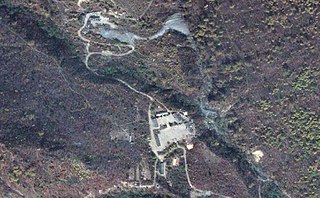
North Hamgyong Province is the northernmost province of North Korea. The province was formed in 1896 from the northern half of the former Hamgyong Province.

Chŏngjin is the capital of North Korea's North Hamgyong Province (함경북도) and the country's third-largest city. It is sometimes called the City of Iron.

The Tonghae Satellite Launching Ground(동해위성발사장), also known as Musudan-ri (Korean: 무수단리), is a rocket launching site in North Korea.

Voice of Korea is the international broadcasting service of North Korea. It broadcasts primarily information in Chinese, Spanish, German, English, French, Russian, Japanese and Arabic. Until 2002 it was known as Radio Pyongyang. The interval signal is identical to that of Korean Central Television.
Cave Springs High School is an American high school for grades 9–12 in Bunch, Adair County, Oklahoma. In 2006 it had an enrollment of 129. It is the only high school in the Cave Springs School District.

Hamamatsu Arena is a multipurpose indoor sporting arena located in Hamamatsu, Shizuoka, Japan. It is a 15-minute walk from Tenryūgawa Station on the Tōkaidō Main Line railway, or a 10-minute drive from the Hamamatsu Interchange on the Tōmei Expressway.

Nam District is a gu, or district, in south-central Busan, South Korea. Much of Nam-gu sticks out into the Sea of Japan, forming a peninsula which separates Suyeong Bay from Busan Harbor. It has an area of 25.91 km2. Nam-gu officially became a gu of Busan in 1975. In 1995 part of Nam-gu was divided to form Suyeong-gu.

Portland is an unincorporated community in southeastern Callaway County, Missouri, United States. It is part of the Jefferson City, Missouri Metropolitan Statistical Area. Portland is located just north of the Missouri River on Route 94, approximately 24 miles east-northeast of Jefferson City.

Busanjin District is a gu in central Busan, South Korea. It has an area of 29.7 km2, and a population of about 410,000. The name is sometimes abbreviated locally as "Jin-gu". Busanjin-gu is home to a major shopping, entertainment, and business area called Seomyeon.

Kilju, sometimes romanized as Kilchu, is a county in North Hamgyong province, North Korea. The county seat is Kilju Town.

Kyŏngsŏng County is a kun, or county, on the central coast of North Hamgyong, North Korea. The administrative center is located in Kyŏngsŏng-ŭp.

The 19th Division was an infantry division in the Imperial Japanese Army. Its tsūshōgō code name was the Tiger Division. It was also occasionally referred to in Korean accounts as Ranam Division, after the location of its main base. The 19th Division and the 20th Division were both raised as a garrison force for Korea. After Japan's victory in the Russo-Japanese War of 1904-1905, and subsequent occupation, and then annexation of Korea in 1910, the need was felt for a dedicated garrison force, raised from people with local knowledge. The 19th Division was stationed in far northeast Korea, in what is now North Hamgyong Province. The division received its colors on 24 December 1915 and headquarters have moved to Yongsan District 16 April 1916; however, the division was not considered combat-ready until 1918. The delay was due to limited funding available for the division to build its facilities in Korea and the need to recruit and train personnel from mainland Japan. In addition, the new division was beset with problems related to malaria and shigellosis at its main base at Ranam in northern Korea, having recorded 672 disease-related officers casualties during 1917. As result, the headquarters have moved to Ranam-guyok only 10 April 1919. The first commander of the 19th Division was Lieutenant General Tachibana Koichirō.
Isaiah is a ghost town in Butte County, California, United States. It was located 5.5 miles (8.9 km) north-northwest of Berry Creek, at an elevation of 984 feet. Part of the Bidwell Tract of 1876, It still appeared on maps as of 1948. Isaiah began as a mining community and later was used as a watering station for steam powered trains. Because of the construction of Oroville Dam (1961), the railroad was re-directed. This led to the inhabitants eventually selling their property. It is now privately owned.

Ōwada Station was a train station in Rumoi, Hokkaidō, Japan.

Ulsan Station (Tongdosa) is a South Korean high-speed rail station located in Samnam-eup, Ulju-gun. It is on Gyeongbu High Speed Railway and named Ulsan Station with subname Tongdosa, which is located in Yangsan, nearer than downtown Ulsan from the station. The existing Ulsan Station in Samsan-Dong, Nam-gu has been renamed to Taehwagang station.
Ch'ŏngjin Ch'ŏngnyŏn station (Korean: 청진청년역) is the central railway station in Ch'ŏngjin-si, North Hamgyŏng Province, North Korea. It is the junction point of the Hambuk Line and the P'yŏngra Line of the Korean State Railway, and is the beginning of the Ch'ŏngjinhang Line to Ch'ŏngjin Port.
Kyŏngsŏng station is a railway station in North Korea. It is located on the P'yŏngra Line of the Korean State Railway.

The Kangdŏk Line is an electrified standard-gauge secondary line of the North Korean State Railway running from Namgangdŏk on the P'yŏngra Line to Susŏng on the Hambuk Line.

The P'yŏngra Line is an electrified standard-gauge trunk line of the Korean State Railway in North Korea, running from P'yŏngyang to Rason, where it connects with the Hambuk Line. It is North Korea's main northeast–southwest rail line.

Punggye-ri Nuclear Test Site was the only known nuclear test site of North Korea. Nuclear tests were conducted at the site in October 2006, May 2009, February 2013, January 2016, September 2016, and September 2017.
















